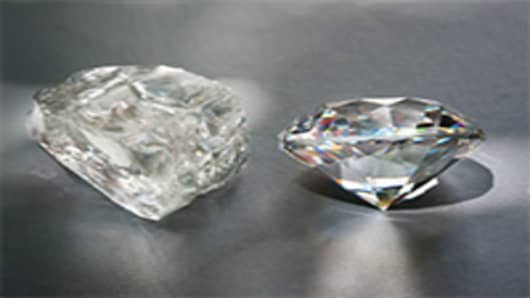The demand for diamonds is dictated by the state of the consumer, with prices affected by economic booms and recessions.
However, one thing that might affect the demand for diamonds is the creation of an investable market for the gem.
The diamond industry has watched the enormous success of gold Exchange Traded Funds (ETFs) (learn more), like the SPDR Gold Trust and the iShares Gold ETF ,with great envy. Some want to see an ETF for diamonds as well, or create others ways diamonds can be made into investments. (Read More: The Billion Dollar Business of Diamonds, From Mining to Retail.)
On the surface, gold and diamonds share several characteristics:
- They have high aesthetic value.
- They are relatively easy to transport.
- There are limited reserves.
But they are also very different. Unlike gold, diamonds:
- Are not homogenous: The price for a stone of the same size can vary tremendously, depending on the color, clarity and quality of the cut. If you sort out the many levels, there's thousands of categories a diamond can fit into.
- Decline in value when they are divided.
- Do not produce sufficient volume to be used as a currency: There is no spot market for diamonds.
Why would anyone want to invest in diamonds?
Some want protection against inflation, for example in China. Others believe that making diamond pricing more transparent would open the relatively closed world of diamond dealing and bring in large numbers of new investors. (Read More: Are Diamonds the New Gold for Individual Investors?)
Of course, there are already ways to invest in diamonds. There are diamond stocks: Anglo American, BHP Billiton, Vale , and Rio Tinto all have diamond businesses, but that is only a small part of their overall mining operations.
A few are devoted almost exclusively to diamonds: Petra Diamonds, Mountain Province, Implats, and Lanmin.
But some people want to push it a lot farther. I spent a weekend recently at the largest diamond and jewelry convention in the U.S., in Las Vegas, with 25,000 dealers. There was one gentlemen in particular who was treated like a rock star everywhere he went. His name is Martin Rapaport.
Rapaport isn't a dealer, he runs the Rapaport Price List. It's the industry's go-to list for finding out what a diamond is really worth. It's just a grid of different sizes of diamonds, with colors going down one side and clarities going down the other.
He also runs Rapnet, which he claims is the largest electronic diamond trading network in the world.
He says this is making diamond pricing far more transparent. You can simply look up what the current price of your diamond is by comparing it to asking prices for similar diamonds (same color, cut, clarity and size) that are posted on Rapnet.
Rapaport and others say it's time for diamonds to become investable products. He has plans to create diamond depository receipts, which will enable investors to buy and sell a diamond over the Internet without having to take any delivery. (Read more:How to Invest in Diamonds)
Others are trying to create ETFs directly tied to a basket of diamonds. One firm, GemShares, has filed a patent application claiming it can create a benchmark basket of diamonds that are based on similar cut, color, clarity and carat size. What about the uniqueness of each diamond, the fact that each has its own "sparkle?"
GemShares, in its patent application, claims that "the present invention combines gemological and objective analysis of the diamonds, particularly with respect to light and optical behavior, and thereby eliminates these visual discrepancies and produces a fungible standard for classifying diamonds that can be used to securitize or commoditize diamonds. Diamonds bundled under the present invention would not only be gemologically identical, but also exhibit substantially identical optical characteristics such that they would be visually indistinguishable by anyone."
That is a pretty tall claim.
Another, the Index IQ Physical Diamond Trust, also seeks to create a "fungible" basket of one carat diamonds that are divided into several subcategories. (Read More: Diamond Investing Not for Faint of Heart.)
Not everyone in the industry is enamored with the idea of an ETF. I spoke to many in the diamond industry who do not want to see outsiders who have no emotional attachment to diamonds come into their business. They do not mind the clubby atmosphere at all.
What about making diamond pricing more transparent? Most I spoke to believe it's a good thing, even if they have differences of opinion on what a diamond should price at. But that doesn't mean they believe diamond investing is a good thing.
—By CNBC's Bob Pisani
@BobPisani



